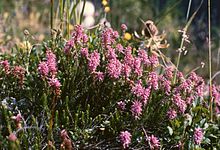Erica spiculifolia: Difference between revisions
Content deleted Content added
copyedit |
copyedit |
||
| Line 17: | Line 17: | ||
}} |
}} |
||
'''''Erica spiculifolia''''', commonly known as '''spike heath''', is a species of plant native to southeastern Europe and northern [[Asia Minor]]. It is a dwarf evergreen shrub and heath-like plant to 10 in high. Leaves are dark green. The flowers are rose-pink and bell-shaped, in terminal clusters |
'''''Erica spiculifolia''''', commonly known as '''spike heath''', is a species of plant native to southeastern Europe and northern [[Asia Minor]]. It is a dwarf evergreen shrub and heath-like plant to 10 in high. Leaves are dark green. The flowers are rose-pink and bell-shaped, appearing in terminal clusters in early summer. |
||
==Cultivation== |
==Cultivation== |
||
Revision as of 15:10, 7 October 2022
| Erica spiculifolia | |
|---|---|

| |
| Erica spiculifolia | |
| Scientific classification | |
| Kingdom: | Plantae |
| Clade: | Tracheophytes |
| Clade: | Angiosperms |
| Clade: | Eudicots |
| Clade: | Asterids |
| Order: | Ericales |
| Family: | Ericaceae |
| Genus: | Erica |
| Species: | E. spiculifolia
|
| Binomial name | |
| Erica spiculifolia Salisb.
| |
| Synonyms[1] | |
| |
Erica spiculifolia, commonly known as spike heath, is a species of plant native to southeastern Europe and northern Asia Minor. It is a dwarf evergreen shrub and heath-like plant to 10 in high. Leaves are dark green. The flowers are rose-pink and bell-shaped, appearing in terminal clusters in early summer.
Cultivation
The plant prefers sandy peat with lime-free. Propagate from seed, cuttings or division. It is suitable for rock gardens and borders.
References
- ^ Erica spiculifolia Salisb. Plants of the World Online, Kew Science. Accessed 5 October 2022.
